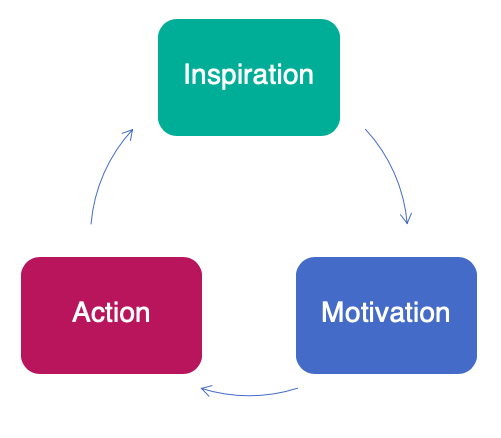You have experienced this multiple times in your life without always being aware of it. Have you ever noticed that your motivation fluctuated depending on the topic and the possible outcome? That there are things you would do without any external incentive, and others that require a reward for you to focus on them? These are called intrinsic motivation and extrinsic motivation. Before we talk about the principle, it’s important we learn more about them.
The different types of motivation

Intrinsic Motivation
An article published by Stefano I. Di Domenico and Richard M. Ryan on the US National Library of Medicine explains what intrinsic motivation is:
When we are curious about something we find interesting, our behaviours align to develop our knowledge, our exposure to it. We make time, we prioritise, we research it, we take action more easily. It is said of intrinsic motivation that it predicts “enhanced learning, performance, creativity, optimal development and psychological wellness”.
There are rewards to intrinsic motivation, but they are intangible. They can bring you happiness, open-mindedness; they can make you feel more accomplished and independent; your curiosity is enough for you to be interested in something.
For instance, that’s what happened to me with psychology. I got interested in personal development when I became a manager. The more I read about it, the more I got interested in coaching. My intrinsic motivation was to feel like I was helping others to have an impact on their life. As I started learning about coaching, I discovered a whole new world (for me): psychological models and principles. I got more curious about it, and I’m now registered to start a Bachelor’s degree in Psychology in a couple of months. All that without knowing that I would choose this career path. I did it because I wanted to learn.
Extrinsic Motivation
Extrinsic motivation, on the other hand, is stimulated by external rewards, whether they are positive (benefits, money, bonus) or negative (avoiding punishment). The tasks and behaviours that originate from extrinsic motivation are usually adequate to the rewards. Those are set by external sources, who decide what the reward will be, and how to get it.
Extrinsic motivation is more short-term oriented and has less impact on the learning. The satisfaction provided by the reward only lasts a short time until we feel like achieving another reward.
Research has found that extrinsic rewards can sometimes undermine intrinsic motivation when people are engaged in an interesting task. Kou Murayama, an associate professor at the University of Reading, wrote about a study he conducted in 2010:
“Participants were randomly assigned to a reward group or a control group and engaged in a game task while being scanned inside an fMRI machine. Participants in the reward group were instructed that they would receive performance-based monetary rewards whereas participants in the control condition did not receive such instructions (i.e., they played the game just for fun). After the scanning session, we found that participants in the reward group showed less voluntary engagement in the task than those in the control group, indicating that their intrinsic motivation for the task was undermined by the introduction of extrinsic rewards.”
Extrinsic rewards tend to narrow our creativity and limit our will to explore new perspectives. There might be several ways to reach the reward but ultimately, the result, the goal, is always the same, so we go for the simplest.
Think about client services teams incentivized on handling a high volume of email requests: they might enjoy helping clients (intrinsic motivation) but they will choose to send templates rather than personalised emails to reach their target, undermining their initial intrinsic motivation.
The do something principle
 This principle is quite simple to remember and very powerful to apply. The author Mark Manson first wrote about it in 2011 in a blog post, before talking about it in his book “The Subtle Art of Not Giving a Fuck” (which I highly recommend).
This principle is quite simple to remember and very powerful to apply. The author Mark Manson first wrote about it in 2011 in a blog post, before talking about it in his book “The Subtle Art of Not Giving a Fuck” (which I highly recommend).
It is called the “do something” principle.
In order to action something, we need to be first motivated; and to be motivated, we need to be inspired:
Inspiration -> Motivation -> Action
Mark Manson says that it’s actually an endless loop that looks more like this:
Inspiration -> Motivation -> Action -> Inspiration -> Motivation -> Action -> Inspiration -> Motivation -> Action, etc.
 He adds:
He adds:
“The conclusion is that if you lack the motivation to make an important change in your life, then do something, anything really, and then harness the reaction to that action as a way to begin motivating yourself.“
Think about all the times you wanted to do something but were not inspired enough to action it. It can be that the task or action seems too big, or too time consuming, or too unpleasant in that moment. Break it down into smaller things you could do, and start with one. Don’t ask yourself any question, just do it. Do one small action. It will activate the loop of inspiration and motivation, setting you in motion to success.

